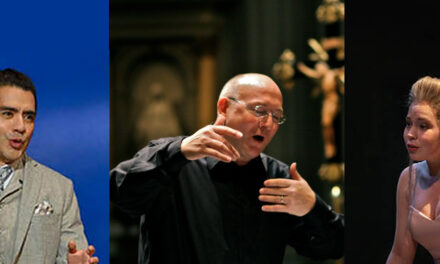Two revered entities met on a torrid Sunday afternoon. The storied Mallarmé Chamber Players launched their twenty-seventh season under the auspices of the even more storied Raleigh Chamber Music Guild, an organization now celebrating its very own seventieth season. And speaking of revered and storied outfits, the North Carolina Museum of Art is co-sponsor of “Sights & Sounds on Sundays,” lending its fine auditorium for the series. The diversified program, “Fantasy and Ambiguity in Musical Form and Style,” was inspired by the Museum’s exhibition, “Alter Ego: A Decade of Work by Anthony Goicolea.”
From Stravinsky’s ballet Pulcinella came the opening Suite Italienne for cello and piano, with cellist Nathan Leyland and pianist Jeremy Thompson. Since the composer had reworked this piece from a much earlier work based on the music of Pergolesi, some of the movements were scarcely evocative of Stravinsky. For example, the leading Introduction and the Serenade were as tuneful as any good romantic composer might have penned. The other four movements sounded like more vintage Stravinsky, calling frequently for real virtuosity, which these players could furnish in abundance. After opening star turns by the cello, both artists collaborated as equals in the exciting Aria, the demanding Tarantella and the Minuet/Finale. The cellist’s transition measures from Allegro to Largo sections of the Aria were especially stirring.
Was that piece too contemporary for your taste? Then let Mallarmé Artistic Director Suzanne Rousso take you back exactly two centuries to Telemann and his Fantasie No. 1 for Solo Viola. In her explanatory remarks she exhibited the proper period short bow and promised strictly controlled vibrato. She delivered pleasingly, particularly to those for whom excessive vibrato tends to bring on stress – even in the Grave movement where the temptation to vibrate must have been intense.
Dovid Friedlander, Associate Concertmaster of the NC Symphony, is a justly and widely celebrated violinist. So it was not his fault that very few left the concert whistling or humming Schoenberg’s Phantasy, Op. 47, for violin and piano. Despite his introductory remarks, this 1950 work could never be accused of being readily accessible. His able colleague was Thompson, who in his earlier solo appearance had wowed the capacity audience with his treatment of Fantasie in F minor, Op. 49, by Chopin. A “big” work by Chopin standards and at times dreamily reflective, this piece was evidently a specialty of the young Canadian-born artist. Playing without score, he demonstrated a talent of huge promise.
All four of the aforementioned players collaborated in what was arguably the musical zenith of the afternoon. At least one member of the audience did not realize that Mahler had ever written any chamber music, let alone a Piano Quartet in A minor. Nothing but those gigantic symphonies and song cycles, right? (Having composed the piece when only fifteen years old, he apparently then got over the urge.) Once you were past the mild shock of hearing the opening piano solo, realizing that it was indeed Mahler, you could then settle in and revel in chamber excellence. The single movement contained no subtleties, only such rich passages one would expect from the composer. And the four players negotiated the work as veteran quartet colleagues rather than just an ad hoc ensemble.
As the works’ titles suggested, fantasy abounded in this grand program, but one might argue about the level of ambiguity. As a result of good management by the RCMG and the NCMA, along with the reputation of the Mallarmé Chamber Players, the crowd filled the goodly auditorium. They were well served.











